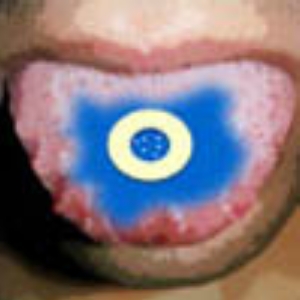
Your taste buds are located in small bumps on the tongue called papillae. Supertasters have more of these bumps per square centimeter of tongue than nontasters, as much as 10 times as many. So the simplest, do-it-yourself way to detect your supertaster status is to look at the papillae on your tongue.
You can make your individual taste bumps visible – and countable – by applying blue food coloring. You may be someone who avoids artificial coloring, so I’ve looked into the safety issues.
Currently there are seven artificial colors allowed in foods. The blue ones are FD&C Blue No. 1 and No. 2. Food colorings got a bad name when FD&C Red No. 2 was found to be carcinogenic. It was banned in 1976. The currently legal colors are probably not harmful, although they may “aggravate” ADD and ADHD (Attention Deficit Disorder and Attention Deficit Hyperactivity Disorder).
When you apply blue food coloring to your tongue, what you’re looking for is the areas that do NOT turn blue. The pink, round dots are the papillae. The pink dots on the tongue above are spaced fairly far apart, which makes them easy to count. This could be the tongue of a mildly sensitive taster, but definitely not a supertaster.
The tongue below belongs to a supertaster. It may not look like it, but it’s been stained blue.
There are so many densely packed papillae that you can hardly see the food coloring. This tongue is less healthy looking than the blue tongue above, which looks like it might belong to a healthy child. The supertaster tongue pictured pictured immediately above has a widening central crack near the tip. The tongue below — with the white reinforcement sticker — has scallops (teeth marks) along the edges. (For healthy and unhealthy tongue characteristics, from the perspective of Traditional Chinese Medicine, check out Beyond Well Being: Tongue Diagnosis.)
The definitive tongue test for supertasting status is to count your papillae. If you have reinforcement stickers for punched paper, you can put one of those on your tongue. If you have a hole-punch and wax paper, that’s the next best thing. Otherwise, use ordinary paper. Dip a Q-tip in the food coloring and paint the inside of the circle. Or you can paint the tongue and then apply the reinforcement, which is what you see in the photo below. Use a magnifying glass and a flashlight to count the papillae inside the circle. You’ll need either a mirror or a friend. You can also try taking a photo and enlarging it.
How many papillae qualify you for nontaster, medium taster, or supertaster? If you search the Internet, you’ll find a wide range of answers. According to The Yale Guide to Children’s Nutrition, which I regard as a reliable source, supertasters typically have 60 or more papillae inside the circle. They may be so dense they’re hard to count. Nontasters typically have 20 or fewer.
Related posts:
A matter of taste
How do you taste?
Orange juice and toothpaste
What is a supertaster?
The genetics of supertasting
Are you a supertaster: Do you really want to know?
Are you a supertaster: How does PROP Taste to you?
Are you a supertaster: DNA testing
Why do we love high-fat foods?
Do we taste fat?
The taste advantage
“Killer” grapefruit?
Grapefruit and the Pill
This is your brain on sugar — and sugar substitutes
The Pepsi challenge: How beliefs affect what you taste
Sources:
(Hover over book titles for more info.)
Milosevic William Tamborlane, Joseph Warshaw, The Yale Guide to Children’s Nutrition





Sorry, comments are closed for this post.